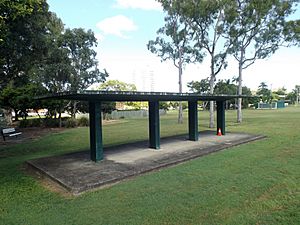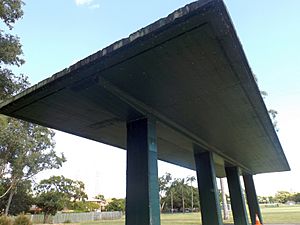Raymond Park (East) Air Raid Shelter facts for kids
Quick facts for kids Raymond Park (East) Air Raid Shelter |
|
|---|---|

Shelter remains in 2015
|
|
| Location | 184 Wellington Road, Kangaroo Point, Queensland, Australia |
| Design period | 1939 – 1945 (World War II) |
| Built | c. 1942 |
| Architect | Frank Gibson Costello |
| Official name: Raymond Park (East) Air Raid Shelter | |
| Type | state heritage (built) |
| Designated | 6 April 2005 |
| Reference no. | 602479 |
| Significant period | 1942 (fabric) 1940s (historical) |
| Builders | Brisbane City Council |
| Lua error in Module:Location_map at line 420: attempt to index field 'wikibase' (a nil value). | |
The Raymond Park (East) Air Raid Shelter is a special old building in Raymond Park, Kangaroo Point, Queensland, Australia. It used to be a safe place during air raids in World War II. A man named Frank Gibson Costello designed it, and the Brisbane City Council built it around 1942. This shelter is now listed on the Queensland Heritage Register, which means it's an important part of history.
Contents
Why Air Raid Shelters Were Needed
The Brisbane City Council built this concrete shelter in Raymond Park in 1942. This was during World War II. On December 7, 1941, the United States joined the war. This happened after Japan bombed the American fleet at Pearl Harbor in Hawaii.
The war then became truly global. Japan bombed Darwin in Australia on February 19, 1942. Many Australians were captured when Singapore fell. People worried that Japan might invade Australia. Queensland was chosen as an important base for the war in the Pacific. Many Australian and American soldiers came to Queensland. They needed new buildings and places to stay very quickly.
Brisbane's Role in World War II
The number of people in Brisbane grew a lot. Brisbane was the biggest city in Queensland. It was also the most northern large city in Australia. Because of this, military planning headquarters were set up in Brisbane. Important places for repairs, communication, and supplies were also built here.
General Douglas MacArthur, who led the Allied Forces, worked from a building in Brisbane. General Sir Thomas Blamey, who led the Australian Forces, used the University of Queensland buildings. Brisbane was a likely target for bombing. So, quick action was needed to protect people from air raids.
Building all these new things needed a lot of materials, services, and workers. Military projects were the most important. Large anti-aircraft guns were placed in different parts of Brisbane. Coastal guns were set up on Bribie and Moreton Islands. Before the war, Queensland did not have many people or big factories. To help, some buildings were made in parts and then put together. Designs for many structures were kept simple. This was because there weren't many skilled workers or certain materials.
Protecting People from Air Raids
The Brisbane City Council was in charge of Air Raid Precautions. This included setting up air raid wardens and firefighting systems. They also built air raid shelters. Large saltwater pipes were laid above ground in city streets. These were to help put out fires.
In late 1941, the government told everyone to start building shelters. This included government buildings, businesses, and homes. Trenches were dug in parks and schoolyards. Windows were taped, and lights were dimmed at night.
The Premier, William Forgan Smith, ordered the Brisbane City Council to build 200 public shelters. Work started in December 1941. Later, 75 more shelters were ordered. But only 235 air raid shelters were built in total. Most were finished by June 1942.
About three kilometers of covered trenches were also built in public parks. For example, there were 315 metres (1,033 ft) of concrete-pipe trenches in the Botanic Gardens. It was thought that one person could fit in each foot of trench. The Council also built shelters for wharves and their own buildings. Shelters were even built under the Story Bridge.
Shelters Across Queensland
The order to build shelters was for all of Queensland's coastal areas. Twenty-four other local councils outside Brisbane were told to build shelters or trenches. These had to follow a special Air Raid Shelter Code. At first, 20 councils were expected to build at least 133 shelters. These shelters were supposed to be strong enough to survive a 500-pound bomb exploding 50 feet (15 m) away.
In the end, 23 councils outside Brisbane built 129 public shelters. Most were above ground, and six were underground. This work cost a lot of money. If a local council couldn't build enough shelters, the Department of Public Works took over. But this caused problems when the Department tried to get half the money back from the councils. Some councils refused to pay. A new law had to be passed in December 1942 to make them pay. The Ayr Shire Council even said the shelters would be "death traps."
Designing Shelters for the Future
Of the 235 public shelters built in Brisbane, 21 are still standing today. The Brisbane City Council still owns them. One special shelter is on Queens Wharf Road. It is different from the standard design. The other 20 shelters can be put into three types. These were designed to be changed after the war. They were called "park," "bus," and "bus (stone)" types.
These shelters were meant to become things like bus stops or shade structures in parks. Some or all of their strong outer walls could be removed. This would leave the concrete roof, floor, and support pillars. Both the reusable shelters and the standard ones were designed to hold 70 people.
Frank Gibson Costello was the Brisbane City Council's City Architect from 1941 to 1952. He designed these surface air raid shelters. He wanted them to be useful after the war. In 1942, Costello said that if the shelters weren't needed for air raids, they would just be unused concrete buildings. He tried to design them so they could be improved and used for other things after the war.
Costello's designs used a modern style of architecture. This style focused on using new materials and planning buildings to be useful. It created a look with straight lines, flat roofs, and strong shapes. Even though the shelters were small, their design showed this modern style. The reusable shelters were often built under fig trees. This helped to hide them from enemy planes.
Types of Reusable Shelters
The first type Costello designed was the "park" type shelter. These had four central pillars holding up the roof. This allowed the four strong outer walls to be removed after the war. There were two entrances at the front. If the walls were made of brick, the shelter was about 40 feet 9 inches (12.42 m) long. If concrete was used, it was about 40 feet (12 m) long.
Out of 37 "park" type shelters, only 17 are still here. You can find them in places like Hefferan Park in Annerley and Albert Park. Two are in Raymond Park in Kangaroo Point. Most are now used as simple park shelters, just as planned. One in Nundah was changed into a toilet block. Another in Kelvin Grove is used as a bus shelter. About half of the remaining park shelters had concrete walls, and half had brick walls.
The second design was the "bus" type shelter. These were made so that three brick walls could be removed. This would leave a concrete back wall and five brick pillars at the front. Like the "park" type, they had entrances at each end of the front. Only two of the 19 "bus" type shelters are still around. They are in Newmarket and Newstead.
The third design was also a "bus" type shelter. But it had a stone back wall instead of concrete. Six stone pillars were added later. The three brick walls could still be removed. Only one of these "colonnade" types is left. It is at King Edward Park.
Most of the buildings made for the war in Brisbane were taken down after World War II. The saltwater pipes, trenches, and sirens disappeared. Many standard shelters that stood in the middle of city streets were also removed. None of the 156 standard shelters built by the Council are still standing. Only one of the 21 special shelters remains. However, 20 of Costello's 58 reusable public shelters have survived. Removing their outer walls gave them a new purpose. Shelters for workers at the Story Bridge Hotel and Howard Smith Wharves also still exist.
The strong outer walls of the Raymond Park (East) air raid shelter were removed after World War II. You can still see where the walls used to be. The shelter's roof and pillars have been painted.
What the Shelter Looks Like
The Raymond Park (East) air raid shelter is a rectangular concrete building. It has a thick floor and a flat roof. Four concrete pillars hold up the roof. There is also a lower part of the floor that you can see. The pillars and roof are painted green. You can still see where the two entrances were on the south side of the roof's underside. The shelter is located near Wellington Road in Raymond Park. It is to the east of the playing fields.
Why It's a Heritage Site
The Raymond Park (East) Air Raid Shelter was added to the Queensland Heritage Register on April 6, 2005. It met the following important rules:
- Shows Queensland's History: This shelter is important because it shows how Brisbane prepared for defense during World War II. It protected people from air raids. It helps us understand how the war affected people living in Brisbane.
- Rare or Uncommon: Many air raid shelters were built during World War II in Queensland. But not many of them are still standing today. Also, not many buildings built by the Brisbane City Council for the war are still here.
- Shows Key Features: The shelter is strongly built and rectangular. It is also located near where many people live. These features show what a public air raid shelter in Brisbane during World War II was like.
- Creative Design: The Raymond Park (East) air raid shelter is now used as a shade shelter. This shows that its design allowed for other uses after the war. It is a good example of clever design and how concrete was used during World War II.
- Connected to Important People: This air raid shelter is an example of the work done by the City Architect's Office during the war. It especially shows the work of City Architect F.G. Costello.


